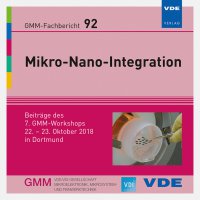Fluorescent E-beam and Photolithographic Resists for Upconversion
Conference: Mikro-Nano-Integration - 7. GMM-Workshop
10/22/2018 - 10/23/2018 at Dortmund, Deutschland
Proceedings: Mikro-Nano-Integration
Pages: 6Language: englishTyp: PDF
Personal VDE Members are entitled to a 10% discount on this title
Authors:
Kaiser, Christian; Schirmer, Matthias; Mai, Tobias; Gerngross, Maik (Allresist GmbH, Strausberg, Germany)
Steglich, Thomas (Präzisionsoptik Gera, Gera, Germany)
Kumke, Michael; Steffen, Marita (Universität Potsdam, Institut für Chemie, Potsdam, Germany)
Abstract:
Many applications require colorized materials. Especially the microscopy of biological samples often involves the need for fluorescent micro- or nanopatterns. We used standard photolithography for the fabrication of well-defined patterns on a µm scale and e-beam lithography to realize structures in a sub-micron range. We evaluated the use of the solvent- developable negative resist Atlas 46 S for this purpose. Different soluble fluorescent dyes and upconverting nanoparticles were added, resulting in an intense emission in wavelength ranges between 350 nm and 720 nm. For e-beam lithography, red and yellow fluorescent dyes and nanoparticles were dissolved or suspended in standard PMMA resists. These dyed resists can be patterned like commonly used positive resist and with standard procedures. The combination of differently dyed resists with suitable dye pairs for photon upconverting as well as the upconverting nanoparticles (UPCN) was investigated. The lanthanide-based UPCNs do not influence the resist matrix, and neither does the resist influence the UPNC’s effectiveness.


